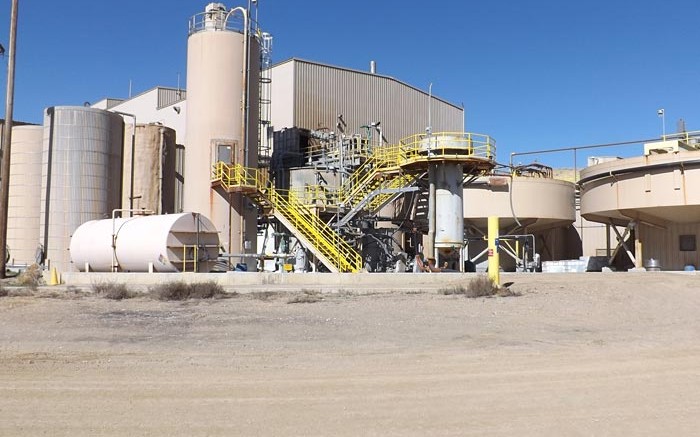Salman Partners’ analyst Derek Macpherson has recently initiated coverage on Klondex Mines (TSX: KDX; NYSE-MKT: KLDX), with a “buy” rating and a one-year, $5-per-share price target.
“The company has exceptional grades, which provide margin protection and financial flexibility in the current gold-price environment, allowing it to organically fund its expected growth,” Macpherson writes in a Dec. 10 initiation report. (Six days later, the Vancouver-based investment broker Salman Partners said it would close down in February 2016, due to tough market conditions.)
Klondex operates two underground gold-silver mines in Nevada: Fire Creek and Midas, which sit 160 km apart.
It started production from the Fire Creek deposit under a bulk-sample permit in the second half of 2013, and added the Midas mine and mill to its portfolio in early 2014. The Midas mill processes ore from both high-grade operations.
Using metal prices of US$1,000 per oz. gold and US$15.83 per oz. silver, updated gold-equivalent reserves at Fire Creek average 45.9 grams per tonne, and at Midas, grade 13.6 grams per tonne.
Along with the high grades, the company’s ability to deliver on its mine plans protect it from the low gold prices, John Seaberg, the company’s vice-president of investor relations, said in a Dec. 16 interview.
“Grade is king in this industry. However, if you have grade and don’t operate it well, you can lose a lot of value. The grade helps, sure — but having good miners and executing on your mine plan will unlock value.”
Since starting production at the narrow-vein, high-grade Fire Creek deposit, Klondex has steadily increased throughput. It has ramped up throughput from 80 tonnes per day in the first quarter of 2014 to 230 tonnes per day in the third quarter of 2015.
Over this time, quarterly gold-equivalent output has climbed from 9,600 oz. to 21,200 oz.
Macpherson forecasts throughput at Fire Creek will continue to increase. He expects the firm will invest US$20 million in capital at the deposit in 2016, and US$16 million in 2017. With this capital spending, the analyst predicts throughput will double to 500 daily tonnes in late 2018, pushing up annual gold-equivalent production to 120,000 oz.
“It’s possible,” Seaberg says of the potential doubling of throughput. “But I would caveat that it is contingent on additional exploration success. Do we think we are going to have exploration success at Fire Creek? Absolutely. It’s only 7% tested — 93% of the land position is untested.”
He adds that the company intends to deliver measured 5–10% growth each year at Fire Creek, explaining that the analyst’s 120,000 oz. production target is “aggressive.”
At the Midas mine, Klondex has improved gold-equivalent output from 4,000 oz. in the first quarter of 2014 to 10,800 oz. in the third quarter of 2015.
Macpherson expects Klondex will keep Midas’ current throughput at 450 to 500 tonnes per day over the next few years. However, he anticipates gold-equivalent production should modestly increase, as gold grades trend upwards, offsetting lower silver grades. Macpherson projects Midas will crank out 81,500 equivalent oz. gold in 2018, up from his 2015 estimate of 56,000 oz.
While the Midas mill has a 1,200-ton (1,089-tonne) daily capacity, only a combined 715 tonnes per day were milled in the third quarter, leaving room for growth.
“The mill is only two-thirds filled … our number-one strategic objective at the company is to fill the mill from Midas and Fire Creek,” Seaberg says. He expects Klondex will reach this target in the next two to three years.
Given the company’s progress to date, its share price has appreciated over the past three years, moving from $1.25 in 2012 to $1.61 in 2013, and to $1.95 in 2014. After hitting a 52-week high of $3.87 per share in August, Klondex ended Dec. 15 at $2.67 per share, up 114% since the end of 2012.
Over the same three years, the spot gold price has fallen 37% to US$1,061.20 per oz.
However, Macpherson points out that Klondex’s shares trade at a discount to its peers, which he believes will rerate, as the company continues to “execute operationally, while demonstrating production and resource growth potential.”
Seaberg attributes the previous share price performance to the company’s execution abilities, adding Klondex will do everything it can to deliver value to its shareholders.
“We run our mines as a business — which is what everyone should do — that generates free cash flow in almost any gold-price environment,” Seaberg says.
In 2015, the company guided consolidated gold-equivalent production of 130,000 to 135,000 oz., up 5,000 oz. from its previous estimate.
It ended September 2015 with a US$60.3-million cash position. On Dec. 17, Klondex proposed to buy the idled Rice Lake gold mining complex in Manitoba for US$32 million.


Be the first to comment on "High grades, good execution keeps Klondex shining"